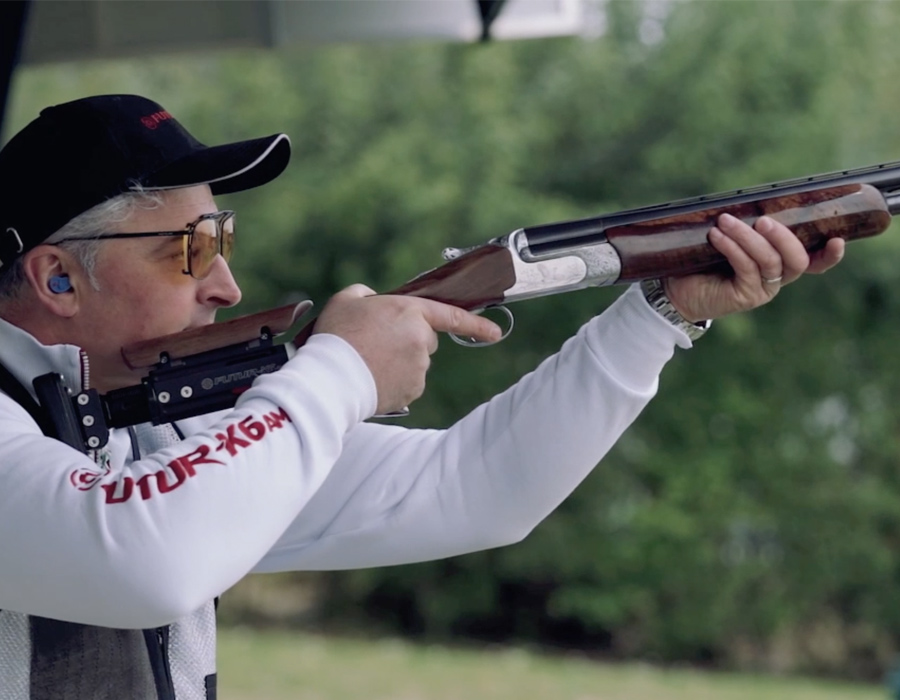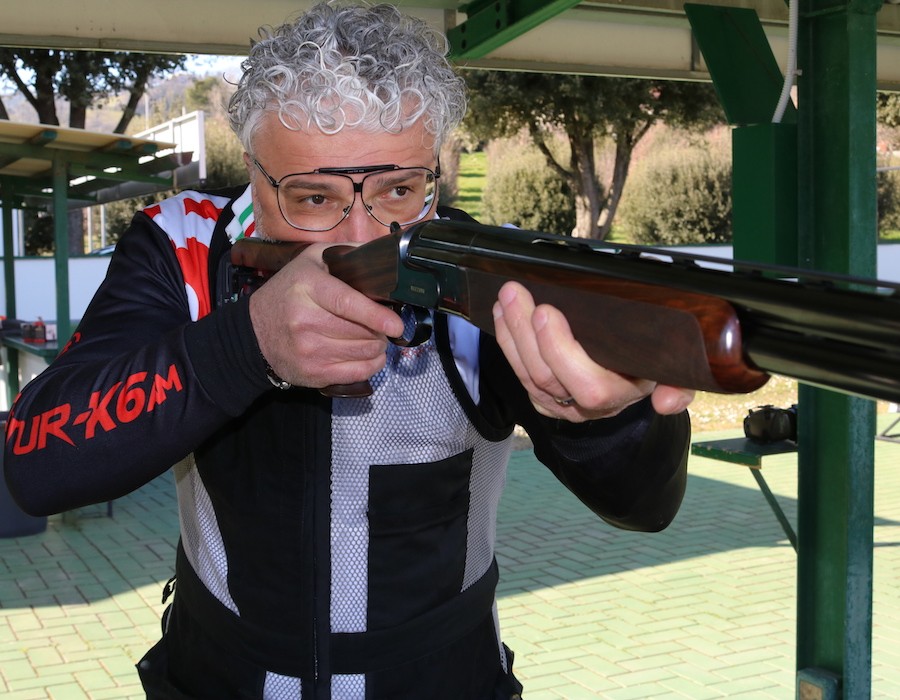From afar, we hear “pull“, and immediately after, an almost fluorescent orange disk appears; it floats through the air, a shot is heard, and a cloud of smoke makes it disappear…It all seems so simple to outsiders, but let’s try to rewind the tape and see what’s behind that colored cloud. For those who fall in love with these colors, sensations, smells, and moments, deciding to become a professional shooter is easy.
Tackling clay pigeon shooting
Tackling this very particular sporting activity, which we know as an Olympic discipline, represents a crucial moment—when you fall madly in love or hate it.
That is why it is important to go to shooting ranges, where federal instructors or people who, in addition to having their own experience in the field, also know how to convey it to beginners.
More often than not, those who approach this sport are not always adults. There are also a lot of interested young adults.
But what do you need to know before you start clay pigeon shooting?
You can begin to gain knowledge about clay pigeon shooting as early as the age of 6, on a theoretical basis, and from 13 on a practical level by going to the shooting range.
In this phase, the shooters of tomorrow begin to be built—those we can help obtain important results at national and international level.
In this article, we will see:
How to become a professional shooter
Clay pigeon shooting is not very publicized by the general public. It is most likely discovered at major events of international importance, such as the Olympics or the World Cup.
But perhaps for this very reason, we have the possibility to dedicate ourselves to young people and help them grow and mature by bringing out the best of their passion.
Giving advice to someone to help them become a professional shooter is not easy, as everyone who has minimum experience in the field will have their own “magic recipe”.
Let’s start by saying that it takes a lot of passion and love to do this sport and, above all, a lot of humility.
Apart from that, we have identified three practical tips that embody the sum of what is needed today to become a professional shooter:
- choose a suitable discipline, relying on qualified personnel;
- train a lot and participate in competitions;
- choose a shotgun and ammunition with care and attention to carry out this activity in the best possible way.
1. Choosing a clay pigeon shooting discipline
The first piece of advice concerns understanding which world you want to be a part of.
Tackling this sport shows beginners a multifaceted and always fascinating reality composed of the different disciplines of clay pigeon shooting, which are:
- Olympic pit
- Skeet
- Compak
- Sporting
- Double Trap
Novice shooters will be stimulated to try them all, certainly, to try to understand which one is the most suited to their way of shooting and their physical peculiarities.
This is probably the first step that an athlete who intends to practice this sport with determination must face.
Once you have identified the specialty you want to try, it is necessary to practice it assiduously.
At this stage, it would be advisable to start following the expert advice of some federal technicians—instructors who help shooters acquire the right and initial setting and follows their path.
This way, all the dynamics, techniques, and timing concerning the activity chosen can be acquired, helping shooters move towards professionalism.
2. Clay pigeon shooting training and participation in competitions
Skill in clay pigeon shooting is not directly proportional to the number of shots fired because many factors come into play when a plate is broken.
However, the series of targets that are “ground” in training serve to acquire the mechanisms of the targets’ release and relative engagement and to refine and improve your technique. They also serve to accustom the shooter’s body to the numerous recoils that they will have to endure during a competition.
Shooting a lot also help gain greater confidence with the shotgun and its rotations, with the ammunition that has been chosen, recording times, and speed of engagement.
When they feel ready, or when the coach following their training believes that the shooter is ready to participate in some competitions, it is advisable to start.
The main reason why they should jump in is to “break the ice” with the psychological tension that each competition puts on the athlete.
At the first few competitions, the skill lies not in the result that is achieved, but in the mental and psychological approach that is determined concerning the different results that have been achieved.
So they shouldn’t feel bad if they have done poorly; they just need to train more to improve. But they also shouldn’t get excited if they have achieved a good result; they should continue learning the various training techniques of clay pigeon shooting with passion and perseverance to maintain their level and aim higher and higher.
Furthermore, by participating in competitions, they have the opportunity to get noticed by teams, coaches, and above all, sponsors who could facilitate the supply of all their shooting needs—ammunition and a shotgun first and foremost.
And remember that they can also train at home if they can’t go to the shooting range!
3. Choosing a shotgun and ammunition, tools for the professional shooter
The third tip concerns the tools that a shooter must have to aspire to become a professional.
First of all, they should know about the anatomy of the shotgun and its characteristics.
It is also appropriate to distinguish between two types of elements: the essential ones and those that they can think about later because they do not give direct feedback on the activity that they are currently doing.
Going to the field with all the top-of-the-range clay pigeon shooting equipment is certainly exciting, but it’s not simple.
Thus, keeping the outfit, earmuffs, glasses, caps, and vests on the backburner, we immediately focus our attention on the crucial elements of clay pigeon shooting, namely the shotgun and ammunition.
These two elements are essential for practicing clay pigeon shooting and will help the shooter improve their performance, obtain results, get noticed, and start moving toward the path of professionalism.
These two tools will be an important investment for their future in shooting, so they should be well-thought-out choices.

How to choose the right ammunition
Choosing the right ammunition is crucial. As beginners, shooters must be given appropriate advice to help them extricate themselves from the abundant production on the market.
Therefore, initially, the coach or instructor who, based on their own experience and the following subject, will indicate two or three brands of ammunition to familiarize themeselves with.
On the other hand, experienced shooters will be able to choose the ammunition that best suits their needs. Continuing on the path of professionalism, they will also be able to collaborate with the production house they have chosen or have been chosen by to tailor the most suitable ammunition to their shooting peculiarities.
After their intital contact with the world of clay pigeon shooting, shooters will understand if this is the world for them and if it is the sport they want to invest their time in.
How to choose a shotgun
Suppose their choice is also backed up by their initial results and the instructor’s assessments. In that case, it is a good idea to choose a suitable shotgun to continue clay pigeon shooting at a more specialized level.
It is always advisable to take small steps by choosing a used shotgun in good condition. However, this choice may be satisfactory regarding the barrels and the gun’s mechanics but unsatisfactory concerning the stock.
As we know, this is where the fulcrum of the shotgun resides and also the shooter’s future.
The shotgun’s stock plays an important role and will make the difference between reaching the set goals and abandoning the challenge even before it has begun.
In fact, we know that the stock will always allow shooters to obtain a tailor-made and balanced shotgun. At this juncture, we are faced with the choice between an adjustable or fixed stock.
We recommend purchasing an adjustable stock that adapts to the shooter’s physical and shooting settings, making their choice of shooting discipline easier. In this regard, in our article, we have talked about the advantages of an adjustable stock for shotguns.
This tool will allow the shooter to interact even more with their shotgun.

To conclude…
For those who intend to take the path of professionalism, owning an adjustable stock means having a tool that will follow the shooter throughout their sporting journey.
And if they decide to replace the shotgun or undergo physical changes like growth spurts, for example, the stock will continue to adapt to their body, ensuring that the shotgun is always perceived as a natural extension.
With this article, we wanted to give you some practical advice on how to become a professional shooter. Leave a comment to tell us what you think!

